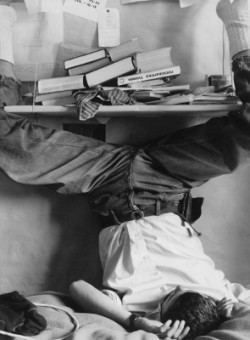The Prague House of Photography in Revoluční Street has finally been opened as part of Prague City Gallery after a decade of waiting. It comes to the Prague gallery scene with the exhibition Slovak New Wave mapping the unbound work of a group of Slovakian photography students at the Prague FAMU during the eighties. They went against the tide of the then prevailing trend of photographing in ateliers as they were not afraid to use the camera in the environment in which they lived and in which they could commonly be found. Thus they challenged the imperative of dividing one’s life between work and leisure time whilst using their own lives as the subject, object, means, and environment of their creation all at the same time.
The exhibition is divided into several different topical units in which the motive of the intermingling of work and leisure is present in each of them, while driven to the extreme in finally erasing the boundaries between them. The author becomes a part of its space and thus also becomes a part of its environment as a subject of the creation standing in front of the camera as his own object and to mediate to himself its process in the unit named Limits of space / Topos of a student’s room / The body as inventory.
Tono Stano, Rudo Prekop, Kamil Varga and Vasil Stanko provide representations of their lives of a claustrophobic environment of narrow dormitory rooms overfilled with unit furniture, cables, utilities, and leftovers of previous days. They use their bodies to construct support columns for the ceiling, sometimes they allow furniture to rest on them while in other cases they themselves rest on the furniture or hang from it and stay connected with it in the photographs for whole decades. In the desolate environment outside they use their bodies to support gigantic static objects and leave their bodies burdened under the enormous weight. Columns and reservoirs forgotten in open space do not allow them to retreat from their place without themselves collapsing into the open field and flooding it.
The bodies on their approach to a predefined space stop being an alien element and become a part of it by accommodating themselves in its formal structure and naturally become one of its components in a similar fashion to leftovers from yesterday’s dinner or melting snow in the fields. There is only a small step from an inconspicuous conformist existence in its structures to self-reduction into mere presence in the sense of an object randomly left in a space that will, in time, befit it. The fact that a body enters a specific space means nothing more than that it is non-humanly present in this space. It has to earn its place as an active factor. Not only to be present in it but to actually be there requires man’s active transformation of it. This need not be strictly material, transforming space means to be self-conscious as existing in this space, as one who has, contrary to shelves attached firmly to the wall, the option of free movement in this space. The only difference between a non-human presence and the being of a man in a specific space is a change of mode of thinking.
The young students of FAMU thus float into the end of the 80’s and carry with them a long- lasting passive frustration of many bedsores which presses them to stretch their limbs that want to wake up.
published: 16. 3. 2014







